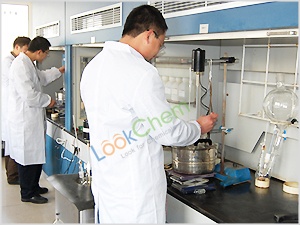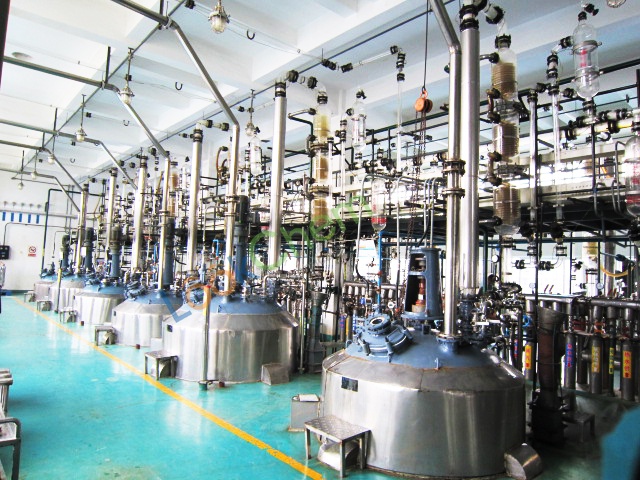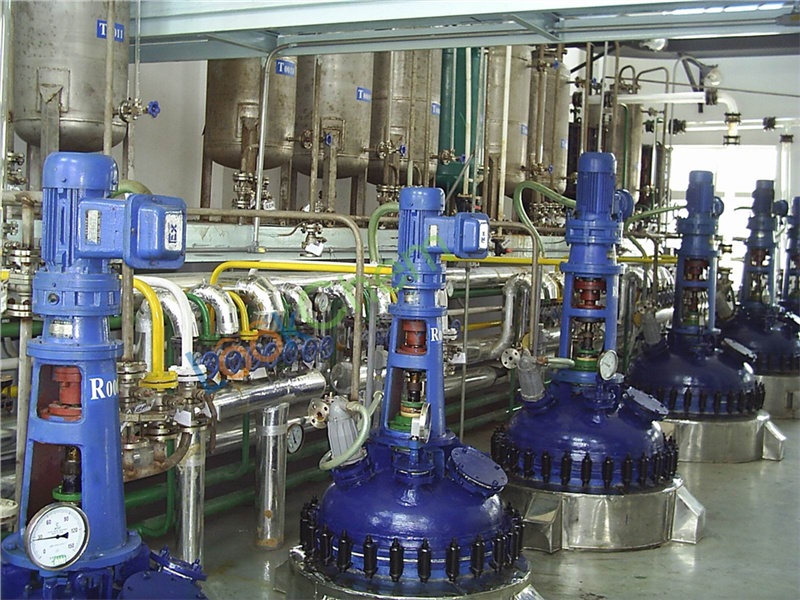Pyrene msds
- Product Details
- Company Profile
The following MSDS detailed information is provided by NANJING AILY BIOTECHNOLOGY CO.,LTD, one specialized pyrene supplier in China.
Section 1: Chemical Product and Company Identification
Product Name: pyrene
Synonym: Benzo[def]phenanthrene;b-Pyrene
Chemical Formula: C16H10
Molecular Weigh: 202.26
Section 2: Hazards Identification
Composition:
Name: pyrene
CAS#: 129-00-0
Section 3: Hazards Identification
Health Hazards Acute And Chronic:
Inhalation: respiratory tract irritation.
Eyes: irritation, damage.
Skin: irritation, dermatitis, acne, reaction, blister.
Ingestion: nausea.
Section 4: First Aid Measures
Inhalation: Remove to fresh air. Give artifical respiration if breathing has sped. Administer oxygen if breathing is difficult.
Eyes: Flush W/Plenty of water for 15 mins.
Skin: Clean area W/corn oil/saterless sleaner, then follow W/soap& water. Don't use solvents to clean. Use hypocortisone cream for relief.
Ingestion: Don't induce vomiting/give anything by mouth. Obtain med attn in all cases.
Section 5: Fire and Explosion Data
lammability of the Product: May be combustible at high temperature.
Auto-Ignition Temperature: Not available.
Flash Points: Not available.
Flammable Limits: Not available.
Products of Combustion: These products are carbon oxides (CO, CO2).
Fire Hazards in Presence of Various Substances:
Slightly flammable to flammable in presence of heat, of combustible materials. Non-flammable in presence of shocks.
Explosion Hazards in Presence of Various Substances:
Risks of explosion of the product in presence of mechanical impact: Not available. Slightly explosive in presence of heat. Non-
explosive in presence of open flames and sparks.
Fire Fighting Media and Instructions:
SMALL FIRE: Use DRY chemical powder. LARGE FIRE: Use water spray, fog or foam. Do not use water jet.
Special Remarks on Fire Hazards: Not available.
Special Remarks on Explosion Hazards: Not available.
Section 6: Accidental Release Measures
Spill Release Procedures: Ventilate area & contain by diking W/sand earth or other inert material to prevent entry into sewers or open bodies of water. Transfer spillage to containers suitable for recovery or disposal.
Other Precautions: Empty containers may contain hazardous liquid or solid residues. Don't flame-cut/weld/puncture. Avoid skin contact. Wash contaminated clothing before reuse. Don't wear contact lenses.
Section 7: Handling and Storage
Precautions:
Keep locked up.. Keep away from heat. Keep away from sources of ignition. Empty containers pose a fire risk, evaporate the
residue under a fume hood. Ground all equipment containing material. Do not ingest. Do not breathe dust. Avoid contact with
eyes. Wear suitable protective clothing. In case of insufficient ventilation, wear suitable respiratory equipment. If ingested, seek medical advice immediately and show the container or the label. Keep away from incompatibles such as oxidizing agents.
Storage:
Keep container tightly closed. Keep container in a cool, well-ventilated area. Do not store above 24°C (75.2°F). Preferably
refrigerate.
Section 8: Exposure Controls/Personal Protection
Eye Protection: chemical splash goggles.
Work Hygienic Practices: Wash hands water after handling& before eating/smoking. Shower after end of work shift.
Section 9: Physical and Chemical Properties
IUPAC Name: pyrene
Molecular Formula: C16H10
Molecular Weight: 202.25
EINECS: 204-927-3
Melting point: 148 °C
Storage temp: Approx 4°C
Form: crystalline
Water Solubility: almost insoluble
Merck: 14,7963
BRN: 1307225
H bond acceptors: 0
H bond donors: 0
Freely Rotating Bonds: 0
Index of Refraction: 1.851
Molar Refractivity: 72.46 cm3
Molar Volume: 161.9 cm3
Surface Tension: 59.4 dyne/cm
Density: 1.248 g/cm3
Flash Point: 168.8 °C
Enthalpy of Vaporization: 62.99 kJ/mol
Boiling Point: 404 °C at 760 mmHg
Vapour Pressure: 2.28E-06 mmHg at °C
Section 10: Stability and Reactivity Data
Stability: The product is stable.
Instability Temperature: Not available.
Conditions of Instability: Excess heat, incompatible materials
Incompatibility with various substances: Reactive with oxidizing agents.
Corrosivity: Not available.
Special Remarks on Reactivity: Not available.
Special Remarks on Corrosivity: Not available.
Polymerization: Will not occur
Section 11: Toxicological Information
Routes of Entry: Inhalation. Ingestion.
Toxicity to Animals: Acute oral toxicity (LD50): 800 mg/kg [Mouse].
Chronic Effects on Humans:
CARCINOGENIC EFFECTS: 3 (Not classifiable for human.) by IARC. MUTAGENIC EFFECTS: Mutagenic for mammalian
somatic cells. Mutagenic for bacteria and/or yeast.
Other Toxic Effects on Humans:
Hazardous in case of ingestion, of inhalation. Slightly hazardous in case of skin contact (irritant, permeator).
Special Remarks on Toxicity to Animals: Not available.
Special Remarks on Chronic Effects on Humans:
May affect genetic material (mutagenic). May cause cancer (tumorigenic) according to animal data.
Special Remarks on other Toxic Effects on Humans:
Acute Potential Health Effects: Skin: May cause skin irritation. May be absorbed through skin. Eyes: May cause eye irritation.
Conjunctival irritation may be noted. Inhalation: May cause respiratory tract irritaiton. Ingestion: May cause gastrointestinal
tract irritation. May affect behavior/Central Nervous System (excitation and muscel spasicity), liver and urinary system, and
immune system, and blood.
Section 12: Ecological Information
Ecotoxicity: Ecotoxicity in water (LC50): 1.8 mg/l 48 hours [Water flea].
BOD5 and COD: Not available.
Products of Biodegradation:
Possibly hazardous short term degradation products are not likely. However, long term degradation products may arise.
Toxicity of the Products of Biodegradation: The products of degradation are less toxic than the product itself.
Special Remarks on the Products of Biodegradation: Not available.
Section 13: Disposal Considerations
Waste Disposal:
Waste must be disposed of in accordance with federal, state and local environmental control regulations.
Section 14: Transport Information
DOT Classification: Not a DOT controlled material (United States).
Identification: Not applicable.
Special Provisions for Transport: Not applicable.
Section 15: Other Regulatory Information
Federal and State Regulations:
Connecticut carcinogen reporting list.: Pyrene Illinois chemical safety act: Pyrene New York release reporting list: Pyrene
Pennsylvania RTK: Pyrene Massachusetts RTK: Pyrene Massachusetts spill list: Pyrene New Jersey: Pyrene New Jersey
spill list: Pyrene Louisiana RTK reporting list: Pyrene Louisiana spill reporting: Pyrene California Director's list of Hazardous
Substances: Pyrene TSCA 8(b) inventory: Pyrene TSCA 8(a) CAIR: Pyrene TSCA 8(d) H and S data reporting: Pyrene: June
1, 1987-June1, 1997 SARA 302/304/311/312 extremely hazardous substances: Pyrene CERCLA: Hazardous substances.:
Pyrene: 5000 lbs. (2268 kg)
Other Regulations: EINECS: This product is on the European Inventory of Existing Commercial Chemical Substances.
Other Classifications:
WHMIS (Canada): Not controlled under WHMIS (Canada).
DSCL (EEC):
R20/21/22- Harmful by inhalation, in contact with skin and if swallowed. S2- Keep out of the reach of children. S36/37- Wear
suitable protective clothing and gloves. S46- If swallowed, seek medical advice immediately and show this container or label.
HMIS (U.S.A.):
Health Hazard: 2
Fire Hazard: 1
Reactivity: 0
Personal Protection: C
National Fire Protection Association (U.S.A.):
Health: 2
Flammability: 1
Reactivity: 0
Specific hazard:
Protective Equipment:
Gloves (impervious). Synthetic apron. Not applicable. Safety glasses.
Section 16: Other Information
References: Not available.
Other Special Considerations: Not available.
Verified Supplier
NANJING AILY BIOTECHNOLOGY CO.,LTD
- Country:
 China (Mainland)
China (Mainland) - Business type: Lab/Research institutions
- Integral:


Contact Details|Similar Products

Escrow ServiceMore
Secure Your Orders With escrow More Transparency,Less Uncertainty


 Add to inquiry cart
Add to inquiry cart



